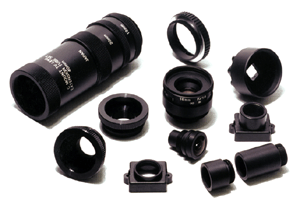High resolution lenses for machine vision — standard and custom lens design
Brief History Of C-Mount Lenses
High Resolution Lenses for machine vision, instrumentation, inspection and vibration-sensitive applications. Standard and custom hi-res lens assemblies.

C-Mount Lenses
C-mount lenses are not new, but they are enjoying a surge in popularity with photographers in recent years because of their ability to adapt to new camera formats. Interchangeable lenses have long been used by photographers as they allow for different images and effects to be captured and make the camera itself more versatile.
It’s believed that the “c’ in C-mount is named after “cine” or from their use in early cine cameras. The C-mount lens is believed to have been introduced to the market in 1932 by Eastman Kodak for use with 16mm film. The Bell & Howell Filmo 70 camera, a single lens model, utilized a C-mount; this camera had three lenses on a revolving turret offering the photographer varying focal lengths.
By the late 1920s, many more camera manufacturers had introduced their own version of the C-mount lens to the market to integrate with the latest models of cameras that were being produced.
The earliest C-mount lenses were produced for 16mm film cameras but were eventually made to accommodate 8mm film models, this happened in the early 1950s when they were being utilized by television cameras as well as film cameras.
Cameras used by television crews didn’t “require the same resolution in a lens as 16mm film” but as time passed the lenses were developed specifically to be used by television cameras because those cameras utilized much larger apertures. Using the C-mount lens devices was popular until the mid-1980s when CCD sensors were introduced into the market.
Today’s technology has progressed to the point where most C-mount lenses are used for CCTV and industrial lens industries.
Universe Optics manufactures C-mount lenses as well as standard and custom-designed plastic lens mounts and accessories, step rings, filters, and components.